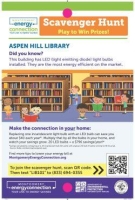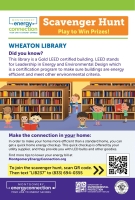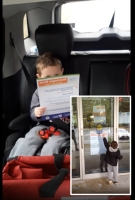MoCo Energy Connection Scavenger Hunt Partnership
Montgomery County Public Libraries
Innovation Synopsis
Montgomery Energy Connection Scavenger Hunt is a fun, self-paced exploration and discovery activity for all ages. In this partnership with the Department of Environmental Protection, residents visit libraries, scan QR codes on outside signs to learn how energy and water efficiency impact buildings/businesses and how to be more energy efficient at home.
Challenge/Opportunity
With the closure of facilities due to COVID19, the Department of Environmental Protection contacted MCPL about a countywide scavenger hunt to encourage residents to visit buildings, scan QR codes to learn energy efficiency. MCPL supplied a list of green features particular to each library that residents could view upon scanning the QR codes. They also learned energy tips for home such as how changing to an LED bulb can save about $40/year; changing 20 to LED bulbs could save $796/year. Residents were also able to win prizes.
Key Elements of Innovation
This partnership inspired residents of all ages to get out and visit areas in Montgomery County during the pandemic. The initial program began with libraries, recreation centers, senior centers and parks but grew to other businesses and buildings. The program did not require any action for library staff (only the time of the staff person supplying the building facts) nor did it require a huge budget. Metal signs, with the QR codes, were adhered to outside structures and removable paper promotional signs were posted.
Achieved Outcomes
Residents were able to get out during the pandemic (exercising social distancing) to learn green facts about LED bulbs, green roofs, thermal cameras, solar panels, compost bins, rainscapes, storm water management, water bottle fillers, and green tips for the home. The program was promoted through social media, county websites, with Holds to Go pickups, and at parks and recreational centers. The program was initially designed to be held during Energy Action month (October) but was soon expanded to a year-long program.



